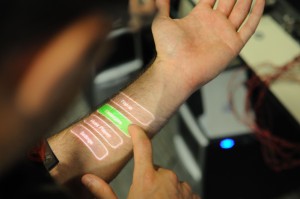Skinput, a new technology, listens to the vibrations of your body and turns it into a touching interface.
One of the newest invention ideas in interface devices is Skinput which is the product of a collaboration between Carnegie Mellon’s Harrison, Desny Tan and Dan Morris of Microsoft Research. Previous attempts at using projected interfaces used motion-tracking to determine where a person taps. Skinput uses a series of sensors to track where a user taps on his arm. It uses a different and novel technique: It “listens” to the vibrations in your body.
This skin-Touch interface provides the users with facility of use of their hands and arms as a touch-screen. With the help of vibrations the sound units are detected and different tasks are performed like management of audio devices, enjoying games etc.
An armband projects the image of a menu or keyboard onto your hand or forearm. This armband contains a bio-acoustic sensor that can detect and analyze sound frequencies. Because of bone density, joints, and soft tissue, different locations on the body have different acoustic properties. When you tap your finger on different parts of your body it creates a unique frequency based on the specific area.
Skinput can detect what part of a projected image you are touching and in turn can transmit a wireless signal to a computer, smart phone or other devices.
It is fairly simple to associate those tappable areas with different commands in an interface, just as different keystrokes and mouse clicks perform different functions on a computer.
When coupled with a small projector, Skinput can simulate a menu interface like the ones used in other kinds of electronics. Tapping on different areas of the arm and hand allow users to scroll through menus and select options.
This device could also be used without a visual interface. For instance, with an MP3 player one doesn’t need a visual menu to stop, pause, play, advance to the next track or change the volume. Different areas on the arm and fingers simulate common commands for these tasks, and a user could tap them without even needing to look.
With this technology, users are capable of managing audio devices, play games, create phone calls and navigate stratified browsing systems.
For more information please visit:
https://volumeoftech.wordpress.com
http://www.inventor-strategies.com


Comments are closed.